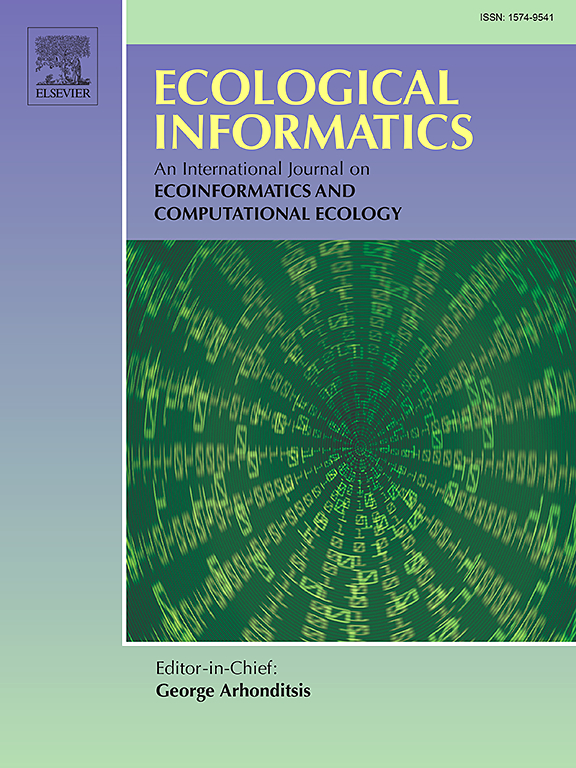A multi-source approach combining GEDI LiDAR, satellite data, and machine learning algorithms for estimating forest aboveground biomass on Google Earth Engine platform
IF 5.8
2区 环境科学与生态学
Q1 ECOLOGY
引用次数: 0
Abstract
Monitoring changes in carbon stocks through forest biomass assessment is essential for understanding the carbon cycle. However, acquiring timely and reliable ground measurements poses challenges in creating spatially continuous maps of forests aboveground biomass density (AGB). This study presents a novel approach that combines open-access Global Ecosystem Dynamics Investigation (GEDI) LiDAR data with satellite observation datasets to estimate and map the AGB and to enhance the accuracy and availability of biomass assessments, ultimately contributing to better insights into forest carbon dynamics. The primary objectives of this study are to: 1) evaluate the potential of combining optical and microwave satellite observations for estimating forest aboveground biomass, 2) compare the performance of different machine learning (ML) algorithms—Random Forest (RF), Classification and Regression Trees (CART), Gradient Tree Boosting (GTB), and Support Vector Machine (SVM)—in estimating forest aboveground biomass using the Google Earth Engine platform. Among the selected models, the GTB model demonstrated the best performance, achieving an R2 value of 0.77, MAE of 22.27 Mg/ha, and RMSE of 37.78 Mg/ha using Sentinel-2 bands and topographic derivatives. The RF model achieved an R2 value of 0.74, value of 0.74, MAE of 31.34 Mg/ha, and RMSE of 39.93 Mg/ha using Sentinel 2 bands, Sentinel 2 Vegetation Indices, Topographic derivatives, and Canopy's height. The RF model followed closely with an R2 value of 0.74, value of 0.74, MAE of 31.34 Mg/ha, and RMSE of 39.93 Mg/ha using Sentinel 2 bands, Sentinel 2 Vegetation Indices, Topographic derivatives, and Canopy's height. The CART model achieved an R2 value of 0.68, MAE of 33.16 Mg/ha, and RMSE of 39.97 Mg/ha using Sentinel 2 bands, Sentinel 2 Vegetation Indices, Sentinel 1 bands, Sentinel 1 Vegetation Indices, Topographic derivatives, and Canopy's height. Meanwhile, the SVM model performed the worst, with a maximum R2 of 0.37, MAE of 55.17 Mg/ha, and RMSE of 73.48 Mg/ha using Sentinel 2 bands, Sentinel 2 Vegetation Indices, Sentinel 1 bands, and Sentinel 1 Vegetation Indices. The results highlighted that integrating Sentinel-2 bands, vegetation indices, topographic data, and canopy height significantly improved model performance. The study emphasizes the importance of multi-source data for enhancing AGB estimation and suggests that the GTB model offers the most reliable predictions. These findings can guide future research in forest biomass mapping using machine learning and remote sensing techniques.
求助全文
约1分钟内获得全文
求助全文
来源期刊

Ecological Informatics
环境科学-生态学
CiteScore
8.30
自引率
11.80%
发文量
346
审稿时长
46 days
期刊介绍:
The journal Ecological Informatics is devoted to the publication of high quality, peer-reviewed articles on all aspects of computational ecology, data science and biogeography. The scope of the journal takes into account the data-intensive nature of ecology, the growing capacity of information technology to access, harness and leverage complex data as well as the critical need for informing sustainable management in view of global environmental and climate change.
The nature of the journal is interdisciplinary at the crossover between ecology and informatics. It focuses on novel concepts and techniques for image- and genome-based monitoring and interpretation, sensor- and multimedia-based data acquisition, internet-based data archiving and sharing, data assimilation, modelling and prediction of ecological data.
 求助内容:
求助内容: 应助结果提醒方式:
应助结果提醒方式:


